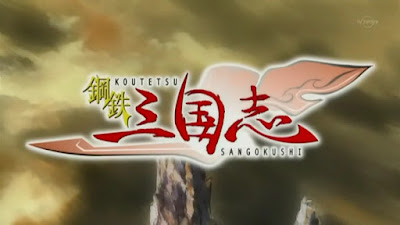In that regard I can sort of see why, whenever anime adaptations of Romance were made back in the 80s & 90s, the focus was put primarily on Liu Bei & Cao Cao, as those two made for the perfect "protagonist/antagonist" pairing, and Wu would only really get involved when it came to the iconic Battle of Chibi (& Sun Jian discovering the imperial seal, before that). Also, despite their importance in the overall story of the era itself, Wu was kind of doing its own thing for the most part, as once Sun Ce found a proper home for his people before his death they were essentially an uninvolved third party until Cao Cao started encroaching on their territory & Zhuge Liang decided to use Wu to help hold back Cao Cao's ambitions, in order for Liu Bei to properly establish his own kingdom of Shu. Still, there is an interesting story to be found within Wu, and in 2007 a TV anime would be produced that finally put the focus on the seemingly oft-ignored third kingdom. Co-produced by NAS and (of all companies) Konami Digital Entertainment, Koutetsu Sangokushi/Steel Three Kingdoms debuted in late-night on TV Tokyo on April 5, 2007 & was part of a larger multimedia "Koutetsu Sangokushi Project" which included a manga version by KYO that actually came first in late 2006, as well as a radio program that debuted the prior January & aired throughout the entire year, two light novels that acted as both a prequel & collection of side stories, a trio of drama CDs, and even a stage show in June of 2008. Oddly enough, considering that Konami's literal video game division was a co-producer, there was no Koutetsu Sangokushi video game... and this was back when Konami was still very much active in the video game business, as seen the last time Konami was related to an NAS-produced TV anime.
Anyway, I remember when Koutetsu Sangokushi first debuted back in the day & I was admittedly a bit curious about giving it a go, since I super into Dynasty Warriors 5 & felt that it was cool to see Wu be given the focus in an anime, for once. So I gave the show a try via the fansubs as it was coming out, but after a few episodes just never got back to it, partially due to how... different it was; I'll get to that in a bit. However, this show would wind up being the first (&, to this day, only) TV anime adaptation of Romance of the Three Kingdoms to ever see an official English release when it was added to Viki's catalog for streaming in May of 2012, alongside Don Dracula, The Three-Eyed One, & Marvelous Melmo; yeah, one of these is not like the others, for sure. However, unlike the modern Rakuten Viki that exists, this was back when Viki almost exclusively relied on crowd-sourced translations for all of its offerings (the first 19 episodes of Koutetsu were subbed as of the ANN news article, but I can't vouch for the rest), and the site itself wasn't really known that much by anime fans in the first place; regardless, it's definitely not streaming anywhere officially in English anymore. Despite how I wound up trailing off of the show back in the day I still always have had some curiosity about Koutetsu Sangokushi, and since this year I decided to watch & review a bunch of anime adaptations of Romance I might as well include this series in the festivities, mainly because it's the de facto Wu-focused adaptation... even though it's easily the loosest "adaptation" of them all.





